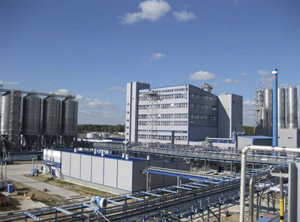UHDE INVENTA-FISCHER
MTR-powered PET line for Russia's Alco-Naphtha starts operations in Kaliningrad / “Biggest single-train PET plant in Europe”
 Uhde Inventa-Fischer supplied all the necessary equipment for Alco-Naphtha’s new PET line in Kaliningrad (Photo: UIF) |
Thanks to a collaboration between Uhde Inventa-Fischer (UIF, Berlin / Germany; www.uhde-inventa-fischer.com) and Russia’s Alco-Naphtha JSC (Moscow; www.alco-naphtha.com), the latter was able in spring this year to commission its state-of-the-art, energy-efficient MTR PET plant in Kaliningrad / Russia. The 240,000 t/y line is claimed to be “the biggest single-train PET plant in Europe” and the first MTR line to be built on European soil.
Plant manufacturer UIF provided the necessary permit engineering, supplied all the equipment and supervised the plant during the construction, installation and commissioning stages. UIF also trained the plant’s operating personnel. UIF's MTR process is based on the company’s 2-reactor high-viscosity technology, which replaces the more cost-intensive solid-state post condensation (SSP) process, allowing for both energy and cost savings. It is also reported to reduce feedstock consumption.
Data published by market researcher Creon (Moscow / Russia; www.creon-online.ru) early this year showed that in 2010 about half the Russian demand for PET was met by imports – a situation that is likely to change drastically with the start of the Kaliningrad line and capacity expansions at other key Russian players. The Moscow-based researcher found that Russia's PET consumption stood at 568,000 t in 2010 – up 14% year-on-year. According to Plasteurope.com's Polyglobe capacity database, Russia can turn out more than 520,000 t/y of PET, and Sibur, Polyef and Gazprom Neft are all planning additional expansions. If all these increases are realised, Russia's PET capacities could exceed 1m t/y by 2015, with Creon estimating that domestic demand will account for roughly 700,000 t/y.
Plant manufacturer UIF provided the necessary permit engineering, supplied all the equipment and supervised the plant during the construction, installation and commissioning stages. UIF also trained the plant’s operating personnel. UIF's MTR process is based on the company’s 2-reactor high-viscosity technology, which replaces the more cost-intensive solid-state post condensation (SSP) process, allowing for both energy and cost savings. It is also reported to reduce feedstock consumption.
Data published by market researcher Creon (Moscow / Russia; www.creon-online.ru) early this year showed that in 2010 about half the Russian demand for PET was met by imports – a situation that is likely to change drastically with the start of the Kaliningrad line and capacity expansions at other key Russian players. The Moscow-based researcher found that Russia's PET consumption stood at 568,000 t in 2010 – up 14% year-on-year. According to Plasteurope.com's Polyglobe capacity database, Russia can turn out more than 520,000 t/y of PET, and Sibur, Polyef and Gazprom Neft are all planning additional expansions. If all these increases are realised, Russia's PET capacities could exceed 1m t/y by 2015, with Creon estimating that domestic demand will account for roughly 700,000 t/y.
17.08.2011 Plasteurope.com 842 [220119-0]
Published on 17.08.2011

 German version of this article...
German version of this article...